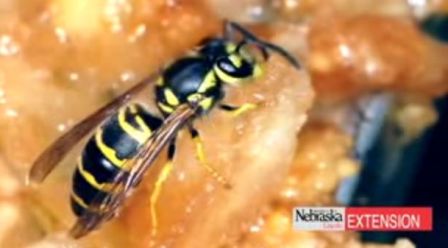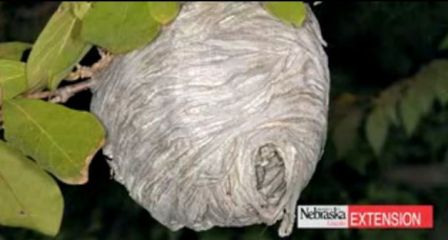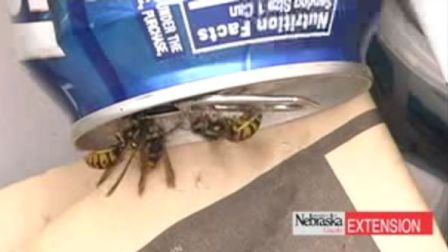The name "yellow-jacket" refers to the yellow and black bands of color on the abdomen of a variety of wasps common to Nebraska. Yellow-jacket management is important because the vast majority of the public regard yellow-jackets as a threat to their safety, as well as impediments to their enjoyment of outdoors.
It is important to remember that all varieties of yellow-jackets are beneficial to the natural environment -they eat large quantities of insect pests such as fly maggots. If a nest does not pose a real, direct threat to people, it is recommended that you leave it alone.
Yellow-jackets (Vespula spp.) are social insects that build enclosed paper nests underground, in trees, or in other structures above ground. There are several different species in the Midwest. In Nebraska, those that are considered pests species are commonly referred to as Western, Sand Hills or German yellow-jackets. Newly-produced queens are the only members of yellow-jacket colonies to survive the winter. Queens emerge from hibernation from late April to May. Having been fertilized by males the previous autumn, the newly emerged queen lays approximately 45 to 70 eggs, which hatch and become the first generation of workers, and forage and care for her offspring.
Colonies grow slowly until mid-summer, when successive worker broods emerge and growth becomes exponential. Colonies typically have 500-5,000 workers at peak population. Each year's population and colony sizes of yellow-jackets in any given area will be affected by the weather, and thus will differ from year to year. For example, sudden cold snaps in the spring can sharply reduce populations for the rest of the year.
Every year in late summer and fall there is a sharp upsurge in the number of stings, due to increased foraging activity in areas frequented by human beings, coupled with aggressiveness brought on due to competition with other wasps and a willingness to sting. By late autumn, colony size has begun to decline. New queens mate and go into hibernation, while males leave to mate and die outside the colony. The old queen and workers die as well with the arrival of cold weather.
Non-chemical control of yellow-jackets includes reducing contact between humans and yellow-jackets in every way possible. All refuse containers should be solid (no wire mesh, etc.) made of plastic or metal and equipped with wasp-tight lids to prevent foragers from gaining access to the interiors. Plastic bag liners aid in sanitation and control of fluids that attract insects as well.
Trapping wasps can at best provide only temporary relief in very limited areas, due to the large nest sizes of many colonies. Consider it after trying the previously mentioned management strategies. Funnel traps using synthetic lures such as heptyl butyrate have been used successfully to capture some yellow-jackets. Traps using raw fish as bait have been used for temporary control. Cut the skin to expose the fish's flesh and suspend it above pans containing water and a wetting agent (like dishwashing soap) to reduce surface tension. Yellow-jackets visiting these traps typically cut large pieces of flesh from the carcass and attempt to carry them to sites where they can chew them into smaller pieces. In so doing, they fall into the water and drown. Advantages of this method include ease of construction, effectiveness, and avoidance of toxic materials.
Other options include applying a dust insecticide such as Sevin® dust, Eight® dust or any other insecticidal dust into the hole after dark when the insects are inside the nest and not guarding the entrance. Do this carefully, following all label information, using a flashlight covered with red cellophane. Bees and wasps don't perceive the color red. Wear garments with long sleeves and pant legs. After the first application, leave the hole undisturbed for about three days, then repeat the dusting procedure and plug the hole with caulk or putty.
Do not use gasoline or other flammable liquids to destroy ground-dwelling yellow-jackets. This poisons the soil and can result in explosions or serious burns. Other chemical controls for yellow-jackets are aerosol products containing a pyrethroid, and a freezing agent to provide rapid quick kill.



